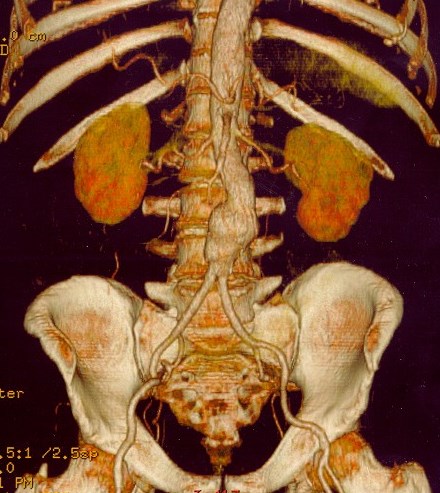Aortic Aneurysm
An aortic aneurysm is an enlargement of the aorta, the main blood vessel supplying blood to the body, to more than 1.5 times its normal size. It often presents without symptoms unless it ruptures, which can cause sudden, severe pain in the abdomen and lower back.
The condition is more common in older adults, especially men, and can be life-threatening if not promptly treated.

Classification
Aortic aneurysms are classified by their location on the aorta:
- Aortic root aneurysm: Located at the sinus of Valsalva.
- Thoracic aortic aneurysm: Found within the chest, further classified as ascending, aortic arch, or descending aneurysms.
- Abdominal aortic aneurysm (AAA): The most common form, located within the abdominal cavity.
- Thoracoabdominal aortic aneurysm: Involves both thoracic and abdominal aorta.
Signs and Symptoms
Most aortic aneurysms are asymptomatic. As they enlarge, they may cause abdominal or back pain. Compression of nerve roots can result in leg pain or numbness. Aneurysms are rarely detectable through physical examination and typically require medical imaging for diagnosis. A hoarse voice may indicate an aneurysm of the arch of the aorta due to stretching of the left recurrent laryngeal nerve.
Abdominal Aortic Aneurysm

AAAs are more common than thoracic aneurysms due to reduced elastin in the abdominal aorta and the absence of vasa vasorum. They often affect individuals aged 65-70 and are associated with atherosclerosis, smoking, hypercholesterolaemia, and hypertension. The risk of rupture increases with the diameter of the aneurysm, particularly beyond 5 cm.

Diagnosis
The diagnosis of an aortic aneurysm is confirmed through medical imaging such as ultrasound or contrast-enhanced abdominal CT scans, which help determine the extent of the aneurysm and guide treatment options.
Risk Factors
- Coronary artery disease
- Hypertension
- Loeys-Dietz Syndrome
- Hypercholesterolaemia
- Hyperhomocysteinaemia
- Elevated C-reactive protein
- Tobacco and alcohol use
- Peripheral vascular disease
- Marfan syndrome
- Ehlers-Danlos type IV
- Bicuspid aortic valve
- Syphilis
- IgG4-related disease
- Pregnancy
- Chronic obstructive sleep apnoea
- Psoriasis
Pathophysiology

Aortic aneurysms result from trauma, infection, or genetic abnormalities affecting the elastin and collagen in the aortic wall. Genetic syndromes like Marfan and Ehlers-Danlos demonstrate a strong genetic component in the aetiology of both thoracic and abdominal aortic aneurysms.
Prevention
Risk reduction involves controlling blood pressure, quitting smoking, and managing cholesterol levels. Ultrasound screening is recommended for high-risk individuals, particularly men over 65.
Screening
The most cost-efficient screening method is an abdominal aortic ultrasound, especially for smokers aged 65 years or older.
Management
Medical Therapy
Medical therapy includes strict blood pressure control, smoking cessation, and the use of statins and beta blockers. Regular ultrasound studies monitor aneurysm size.
Surgery

Surgery is the definitive treatment, especially for large, rapidly expanding, or symptomatic aneurysms. The choice of surgery—open or endovascular—depends on the patient's condition and aneurysm characteristics.
Open Surgery
Involves the insertion of a synthetic graft, with risks including inadequate blood supply to the spinal cord, potentially resulting in paraplegia. Cerebrospinal fluid drainage (CFSD) may reduce this risk.
Endovascular Surgery
A minimally invasive alternative, EVAR has lower short-term mortality but may require additional procedures over time.
Epidemiology
Aortic aneurysms caused approximately 170,000 deaths in 2017, up from 100,000 in 1990.
Self-assessment MCQs (single best answer)
Which of the following is NOT a classification of an aortic aneurysm?
What is the most common form of aortic aneurysm?
Which imaging technique is commonly used to diagnose aortic aneurysms?
Which of the following is NOT a risk factor for developing an aortic aneurysm?
Which genetic syndrome is associated with a higher risk of developing aortic aneurysms?
What is the main blood vessel affected by an aortic aneurysm?
Which of the following is a common symptom associated with a ruptured aortic aneurysm?
Which surgical procedure involves the insertion of a synthetic graft to treat an aortic aneurysm?
Which of the following is a minimally invasive alternative to open surgery for treating aortic aneurysms?
What is the recommended screening method for high-risk individuals for abdominal aortic aneurysm?
Dentaljuce
Dentaljuce provides Enhanced Continuing Professional Development (CPD) with GDC-approved Certificates for dental professionals worldwide.
Founded in 2009 by the award-winning Masters team from the School of Dentistry at the University of Birmingham, Dentaljuce has established itself as the leading platform for online CPD.
With over 100 high-quality online courses available for a single annual membership fee, Dentaljuce offers comprehensive e-learning designed for busy dental professionals.
The courses cover a complete range of topics, from clinical skills to patient communication, and are suitable for dentists, nurses, hygienists, therapists, students, and practice managers.
Dentaljuce features Dr. Aiden, a dentally trained AI-powered personal tutor available 24/7 to assist with queries and provide guidance through complex topics, enhancing the learning experience.
Check out our range of courses, or sign up now!


